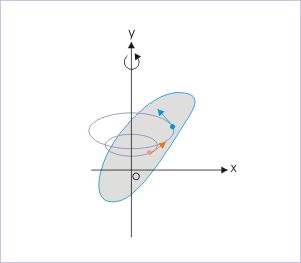Defining Circular Motion
The description of circular motion is described better in terms of angular quantity than its linear counter part. The reasons are easy to understand. For example, consider the case of uniform circular motion. Here, the velocity of particle is changing - though the motion is "uniform". The two concepts do not go together. The general connotation of the term "uniform" indicates "constant", but the velocity is actually changing all the time.

A Rotating Body
Each particle constituting the body executes a uniform circular motion about the fixed axis. For the description of the motion, angular quantities are the better choice.
When we describe the uniform circular motion in terms of angular velocity, there is no contradiction. The velocity (i.e. angular velocity) is indeed constant. This is the first advantage of describing uniform circular motion in terms of angular velocity.
Second advantage is that angular velocity conveys the physical sense of the rotation of the particle as against linear velocity, which indicates translational motion. Alternatively, angular description emphasizes the distinction between two types of motion (translational and rotational).
Relationship Between Linear and Angular Speed
For simplicity, let's consider a uniform circular motion. For the length of the arc subtending angle " at the origin and "r" is the radius of the circle containing the position of the particle, we have
Differentiating with respect to time, we have
Because
Rotational Kinematic Equations
With the relationship of the linear and angular speed/acceleration, we can derive the following four rotational kinematic equations for constant
Mass, Momentum, Energy, and Newton's Second Law
As we use mass, linear momentum, translational kinetic energy, and Newton's 2nd law to describe linear motion, we can describe a general rotational motion using corresponding scalar/vector/tensor quantities:
- Mass/Rotational inertia:
- Linenar/angular momentum:
- Force/Torque:
- Kinetic energy:
For example, just as we use the equation of motion